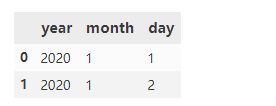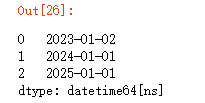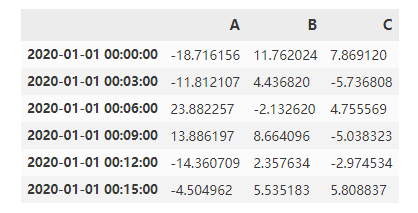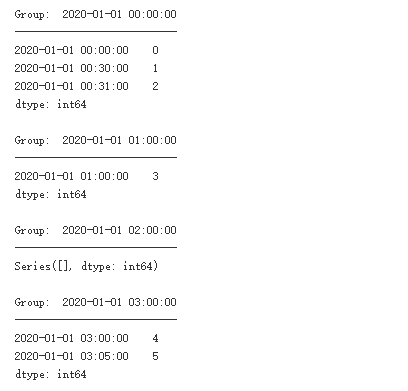Pandas can handle time series in any field. Using Numpy's datetime64 and timedelta64 types, pandas integrates many functions from other Python libraries, such as Scikits.TimeSeries , and create a lot of new functions for processing time series data.
1, Timing creation
1. Four types of time variables
|
name |
describe |
Element type |
How to create |
|
Datetimes (point / time) |
Describe a specific date or point in time |
Timestamp |
to_datetime or date_range |
|
Timespans (time period) |
A period of time defined by a point in time |
Period |
Period or period_range |
|
Dateoffsets (relative time difference) |
Relative size over time (not related to summer / winter) |
Dateoffset |
DateOffset |
|
Timedeltas (absolute time difference) |
Absolute size over time (related to summer / winter) |
Timedelta |
to_timedelta or timedelta_range |
For time Series data, the traditional approach is to represent time components in Series or DataFrame indexes, so that operations can be performed on time elements. However, Series and DataFrame can also directly support time components as data itself. When passed to these constructors, Series and DataFrame extend data type support and functionality for date time, time increment, and period data. However, DateOffset data will be stored as object data.
#Add time component in index, dtype is int64
pd.Series(range(3), index=pd.date_range('2000', freq='D', periods=3))
#Define the time component directly. dtype is datetime64[ns]
pd.Series(pd.date_range('2000', freq='D', periods=3))

2. Creation of time point
Timestamped is the most basic type of time series data that associates values with time points. For pandas objects, this means using point in time.
(a)to_datetime method
Pandas gives a lot of freedom in the input format specification of time point establishment. The following statements can correctly establish the same time point
print(pd.to_datetime('2020.1.1'))
print(pd.to_datetime('2020 1.1'))
print(pd.to_datetime('2020 1 1'))
print(pd.to_datetime('2020 1-1'))
print(pd.to_datetime('2020-1 1'))
print(pd.to_datetime('2020-1-1'))
print(pd.to_datetime('2020/1/1'))
print(pd.to_datetime('1.1.2020'))
print(pd.to_datetime('1.1 2020'))
print(pd.to_datetime('1 1 2020'))
print(pd.to_datetime('1 1-2020'))
print(pd.to_datetime('1-1 2020'))
print(pd.to_datetime('1-1-2020'))
print(pd.to_datetime('1/1/2020'))
print(pd.to_datetime('20200101'))
print(pd.to_datetime('2020.0101'))
#pd.to_datetime('2020\\1\\1') #report errors
#pd.to_datetime('2020`1`1') #report errors
#pd.to_datetime('2020.1 1') #report errors
#pd.to_datetime('1 1.2020') #report errorsUsing format parameter to force matching
print(pd.to_datetime('2020\\1\\1',format='%Y\\%m\\%d'))
print(pd.to_datetime('2020`1`1',format='%Y`%m`%d'))
print(pd.to_datetime('2020.1 1',format='%Y.%m %d'))
print(pd.to_datetime('1 1.2020',format='%d %m.%Y'))You can also use a list to turn it into a point in time index
pd.Series(range(2),index=pd.to_datetime(['2020/1/1','2020/1/2']))
View type
type(pd.to_datetime(['2020/1/1','2020/1/2']))

For DataFrame, if the columns are already in chronological order, use to_datetime can be automatically converted
df = pd.DataFrame({'year': [2020, 2020],'month': [1, 1], 'day': [1, 2]})
pd.to_datetime(df)

(b) Time precision and range limitation
The accuracy of Timestamp is far more than day. It can be as small as nanosecond ns, and its range is
pd.to_datetime('2020/1/1 00:00:00.123456789')
#Minimum range
print(pd.Timestamp.min) #output:Timestamp('1677-09-21 00:12:43.145225')
#Maximum range
print(pd.Timestamp.min) #output:Timestamp('2262-04-11 23:47:16.854775807')(c)date_range method
start/end/periods / freq (interval method) is the most important parameter of this method. Given three of them, the remaining one will be sing ed
The freq parameters are as follows:
|
Symbol |
D/B |
W |
M/Q/Y |
BM/BQ/BY |
MS/QS/YS |
BMS/BQS/BYS |
H |
T |
S |
|
describe |
Days / working days |
week |
end of the month |
Month / season / year end |
Month / quarter / year end working day |
Month / quarter / year beginning date |
Time |
minute |
second |
3.Dateoffset object
(a) The difference between DateOffset and Timedelta
The characteristic of the absolute time difference of Timedelta is that whether it is winter time or summer time, the increase or decrease of 1 day is only 24 hours
DateOffset relative time difference means that no matter whether a day is 23 / 24 / 25 hours, the increase or decrease of 1 day is consistent with the same time of the day
For example, in the 03 hours of 2020, 29 hours in the UK, the 01:00:00 clock changed 1 hours to 2020, 03 months 29, 02:00:00, and began daylight saving time.
ts = pd.Timestamp('2020-3-29 01:00:00', tz='Europe/Helsinki')
ts + pd.Timedelta(days=1)
ts = pd.Timestamp('2020-3-29 01:00:00', tz='Europe/Helsinki')
ts + pd.DateOffset(days=1)
The tz attribute can be removed to keep the two consistent.
(b) Increase or decrease for a period of time
pd.Timestamp('2020-01-01') + pd.DateOffset(minutes=20) - pd.DateOffset(weeks=2)(c) Various common offset objects
pd.Timestamp('2020-01-01') + pd.offsets.Week(2) #Add two weeks
pd.Timestamp('2020-01-01') + pd.offsets.BQuarterBegin(1) #Start of business quarter(d) offset operation of sequence
Using the apply function
pd.Series(pd.offsets.BYearBegin(3).apply(i) for i in pd.date_range('20200101',periods=3,freq='Y'))
Use object addition and subtraction directly
pd.date_range('20200101',periods=3,freq='Y') + pd.offsets.BYearBegin(3)To customize the offset, you can specify the weekmask and holidays parameters
pd.Series(pd.offsets.CDay(3,weekmask='Wed Fri',holidays='2020010').apply(i)
for i in pd.date_range('20200105',periods=3,freq='D'))2, Index and attribute of time sequence
1. Index slice
rng = pd.date_range('2020','2021', freq='W')
ts = pd.Series(np.random.randn(len(rng)), index=rng)
ts['2020-01-26':'20200726'].head() #The date is from 01-26 to 07-26, and the character itself is converted to reasonableSubset index 2
#Take July data only ts['2020-7'].head() #Support mixed form index ts['2011-1':'20200726'].head()
3. Attributes of time points
Information about time can be easily obtained with dt object
#52 weeks in 2020 pd.Series(ts.index).dt.week #What's the day of the week pd.Series(ts.index).dt.day
Using strftime to modify time format
pd.Series(ts.index).dt.strftime('%Y-Interval 1-%m-Interval 2-%d').head()For datetime objects, you can get information directly from the properties
#Month of the week
pd.date_range('2020','2021', freq='W').month
#Month of the week
pd.date_range('2020','2021', freq='W').weekday #The number of the day of the week with Monday=0, Sunday=63, Resampling
Resampling refers to the resample function, which can be regarded as the group by function of the sequential version
1. Basic operation of example object
The sampling frequency is generally set to the offset character mentioned above
df_r = pd.DataFrame(np.random.randn(1000, 3),index=pd.date_range('1/1/2020', freq='S', periods=1000),
columns=['A', 'B', 'C'])
r = df_r.resample('3min')
r.sum()
2. Sample aggregation
df_r = pd.DataFrame(np.random.randn(1000, 3),index=pd.date_range('1/1/2020', freq='S', periods=1000),
columns=['A', 'B', 'C'])
r = df_r.resample('3T')
#Only one value is required
r['A'].mean()
#Represents multiple
r['A'].agg([np.sum, np.mean, np.std])
#Using lambda
r.agg({'A': np.sum,'B': lambda x: max(x)-min(x)})3. Iteration of sampling group
The iteration of sampling group is similar to that of group by, and each group can be operated separately
small = pd.Series(range(6),index=pd.to_datetime(['2020-01-01 00:00:00', '2020-01-01 00:30:00'
, '2020-01-01 00:31:00','2020-01-01 01:00:00'
,'2020-01-01 03:00:00','2020-01-01 03:05:00']))
resampled = small.resample('H')
for name, group in resampled:
print("Group: ", name)
print("-" * 27)
print(group, end="\n\n")
4, Window function
1.Rolling
(a) Common aggregation
s = pd.Series(np.random.randn(1000),index=pd.date_range('1/1/2020', periods=1000))
#
s.rolling(window=50)
#
s.rolling(window=50).mean()
#min_periods is the threshold value of the number of non missing data points needed
s.rolling(window=50,min_periods=3).mean()In addition, count / sum / mean / median / min / max / STD / var / skew / Kurt / quantity / cov / corr are common aggregate functions
(b) Application aggregation of rolling
When using apply aggregation, just remember that the incoming Series is window size Series, and the output must be scalar,
#Calculate coefficient of variation s.rolling(window=50,min_periods=3).apply(lambda x:x.std()/x.mean()).head()
(c) Rolling based on time
Select the closed='right '(default) \'left'\'both'\'neither' parameter to determine the endpoint inclusion
s.rolling('15D').mean().head()
#Add closed
s.rolling('15D', closed='right').sum().head()2.Expanding
(a) expanding function
The common expanding function is equivalent to rolling(window=len(s),min_periods=1) is the cumulative calculation of the sequence, and apply is also applicable
#rolling s.rolling(window=len(s),min_periods=1).sum().head() #expanding s.expanding().sum().head() #apply s.expanding().apply(lambda x:sum(x)).head()
(b) Several special Expanding type functions
cumsum/cumprod/cummax/cummin are all special expanding cumulative calculation methods
shift/diff/pct_change refers to element relationship
① shift means that the sequence index does not change, but the value moves backward
② diff refers to the difference between the front and back elements. The period parameter indicates the interval, which is 1 by default and can be negative
③pct_change is the percentage change of elements before and after the value, and the period parameter is similar to diff